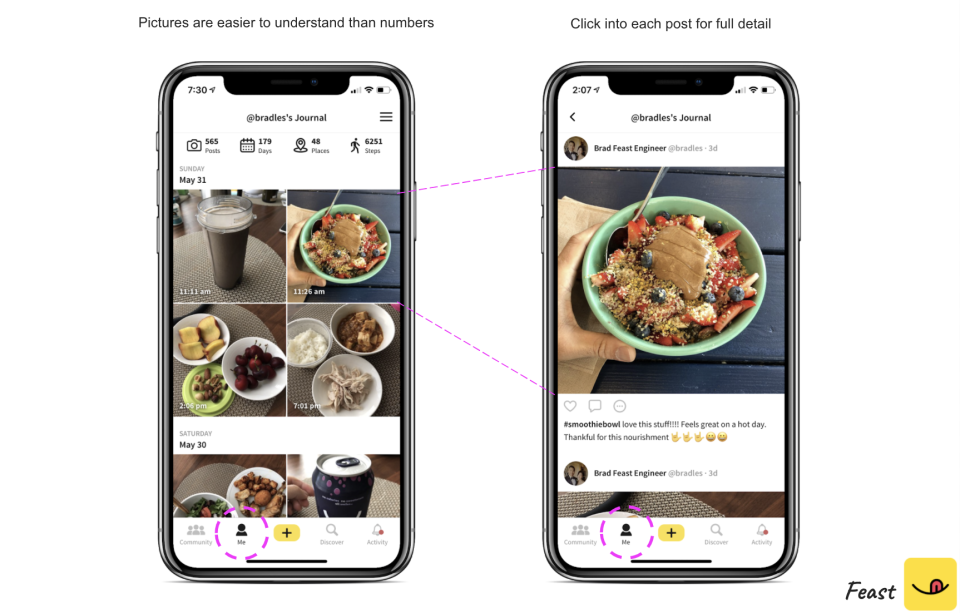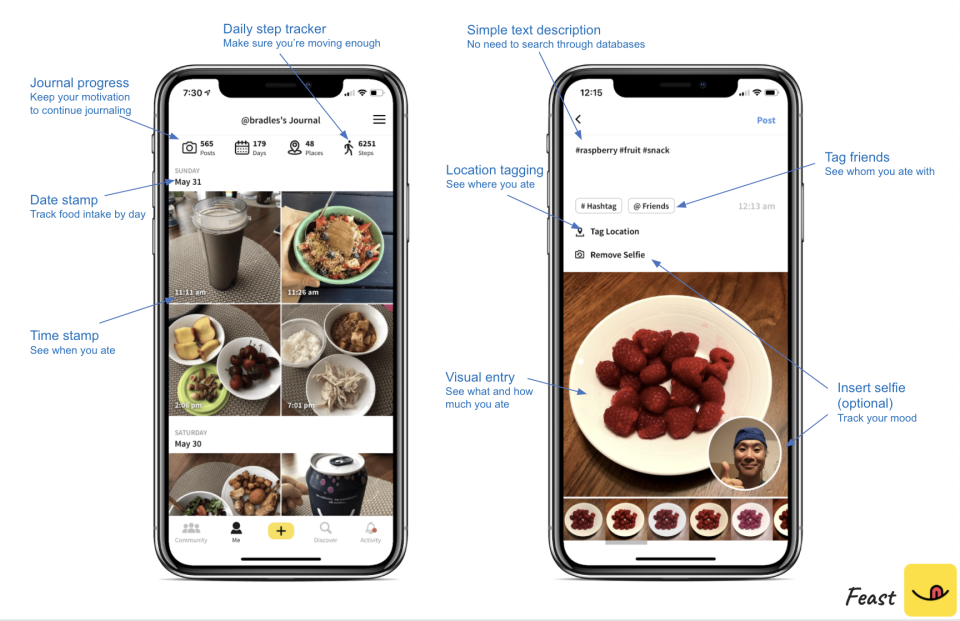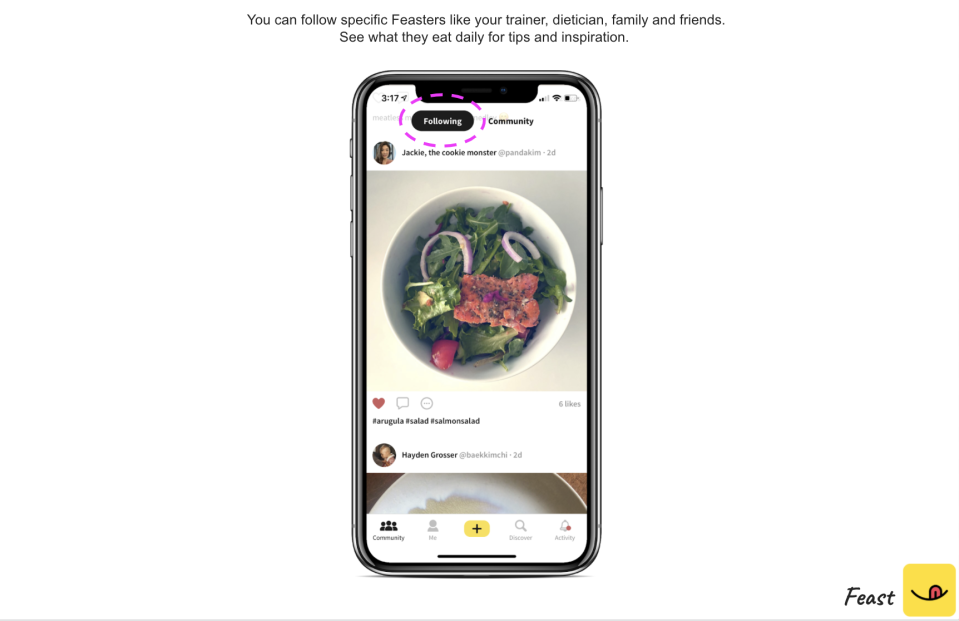Can an Instagram for food-logging help you reach your weight loss goals?
Feast claims that photo-based food logs win out over calorie-counting.
Most diet and weight loss apps, like MyFitnessPal and Lose It, employ the calorie-tracking method of logging your food. You tell the app what you ate -- say, a slice of pizza -- it then estimates the number of calories you consumed. But this method doesn’t always lead to a healthy diet. After all, a can of Diet Coke has zero calories, but it’s probably not as good for you as a 50-calorie serving of broccoli. A new app called Feast, however, aims to solve this issue by not counting calories at all. Instead, it wants to make food-logging as easy as snapping photos of what you eat.
Using the app is simple, take a picture of your meal, add a brief description (with perhaps a hashtag or two -- #lunch or #dumplings etc.) and then post it. By default, your posts are public so that anyone in the Feast community can see it. You also have the option to make your posts private if you’d rather not reveal your dietary secrets to the world.
That might sound a lot like Instagram, but there are a few key differences. One is that your photos are organized by day, so you can view your 24-hour consumption at a glance. Plus, it has Apple Health integration, so you can view your step-count right in the app. You also have the option to note what mood you’re in or tag friends and locations to each photo, just in case you’re having a group meal or are at a restaurant. Also, importantly, Feast is only for photos of food. Posting every single meal and snack you’ve had on Instagram might be a little too much for your followers, whereas it’s the whole point on Feast.

Feast also claims there’s a little bit of artificial intelligence going on. When you enter in the hashtag, it’ll attempt to guess what the foods are in the pictures. This is still very much in beta, but the company hopes that with more photos, the machine learning will improve. Feast hopes that as the AI gets smarter, it’ll be able to add automated insights by analyzing eating history and other health information.
According to founder Jackie Kim, Feast was born out of a frustration with traditional calorie-tracking apps. She was trying to lose weight for her upcoming wedding and found them too restrictive. “I hated how the food trackers reduced foods to numbers where the goal is to eat as little as possible,” she said. “I wanted to find a way where I wouldn’t have to completely stop eating what I love, while still trying to lose weight.”
Instead, she took to snapping photos of her meals to keep herself accountable and then sending herself Slack messages to describe her mood when eating them (This is based on the theory that the food you eat and what mood you’re in are often intertwined). What she found is that this simple act of food logging made her more mindful of what she was eating. With a quick glance at her visual food diary, she would know if she needed to incorporate more greens in her diet, or reduce the amount of carbs and sugary snacks.
What Kim was doing is something nutritionists call “SMART” healthy eating goals (Specific, Measurable, Achievable, Relevant and Time-based). Kathy McManus, Director of the Department of Nutrition and Director of the Dietetic Internship at the Brigham and Women’s Hospital, a teaching affiliate of Harvard Medical School, outlined such benefits of food-logging in a post on Harvard’s Health blog. If you observe that you ate two servings of vegetables per day, she wrote, then you would implement a goal of eating three servings per day on future dates.

Food-logging like this is a relatively common method hailed by nutritionists and dietitians as one of the best ways to lose weight. Studies have shown that it makes you more aware of what you’re eating and that it holds you accountable, making you more likely to make dietary changes. But the methods by which you track your food doesn’t seem to matter as much. Jean Harvey, a professor of nutrition and food sciences at the University of Vermont, Burlington, told WebMD that the consistency and frequency of food tracking is important, but the format is less so. “It can be something like the points WW uses, or it can be simply keeping track of food,” she said.
Some say counting calories can be useful when food-logging as it’s an easy way to quantify how much you’re eating. You’d be able to understand that, for example, a pizza slice has more calories than an apple, and so you should have the apple instead. Others, however, think that calorie-tracking is not quite so beneficial. In an article for Self Magazine, registered dietitian Abby Langer said that she believes it’s a “time-consuming, soul-sucking practice that’s actually a lesson in futility.” Counting calories, she said, can lead to ignoring hunger cues or having the misconception that you can “work off” the food you eat. There are also studies and reports that state calorie-tracking can exacerbate eating disorders.
“It’s time for U.S. and other national policies to stop focusing on calories and calorie counting,” cardiologist Dariush Mozaffarian, dean of the Friedman School of Nutrition Science and Policy at Tufts University told the The New York Times. Instead, Mozaffarian and his colleagues found out that telling people to cut back on added sugar, refined grains and highly processed foods while also eating more vegetables and whole foods, was a lot more effective than telling them to count calories or limit portion sizes.

I tried out a demo version of Feast for a few days, and will admit that I initially found the idea of the app to be almost too simple. All I’m doing is taking a photo of my meal and posting it. I did think the machine learning part of it was intriguing -- it managed to guess that I was eating a bowl of strawberries, for example -- but it didn’t work so well with visually vague dishes like stews and curries. There is, however, nothing that tells me how many calories I’m ingesting, what the nutritional values are, or any of the usual data that comes with calorie-tracking apps. But the more I used it, the more I understood what Kim was getting at. It’s really easy to forget what I’ve eaten on any given day, and having this visual evidence of my food log is a stark reminder of my eating habits, which led me to be more careful of my dietary choices overall.
I was also initially wary of Feast’s social aspect. Would there be public shaming of my not-so-healthy snacks? Surprisingly, however, I have not found that to be a problem. Based on the photos I’ve seen so far on the Feast community page, it seems like members are posting all kinds of food, from cherry pies to avocado toast. So, I followed suit, posting a photo of the handful of Cheetos I had as a snack plus the cheese burger that I had for dinner. Prompted by the photos of these unhealthy food choices, I decided to have a comparatively healthy meal of cauliflower rice with kale and chickpea curry the next day.
As for the shaming part, Kim acknowledged that they were worried about that, too. That’s partly why when you launch the Feast app, you’ll see a splash screen that says “No Judgment Zone,” encouraging users to be honest. Also, when you’re leaving a comment on someone else’s photo, there’s a little note to remind you to “say something nice.” “There’s no Feast police going around to make sure everyone’s posting something healthy,” said Kim, adding that she wants to foster a community where people help each other on their journey. So far, I have not experienced anything but positive comments, but these are early days and it remains to be seen whether the positivity will continue once Feast goes public. Right now, you can delete comments on your own posts if you wish, but the company hasn’t implemented blocking abilities yet.

Despite my positive experience, I still think Feast can be improved. For one, I often found that I needed to be reminded to use the app. There have been several times throughout the week where I simply forgot to take a photo of what I was eating. Timed reminders could be useful here.
Plus, other free weight loss apps like MyFitnessPal and LoseIt have photo-logging abilities too. The process on MyFitnessPal is a little difficult, as you have to tap through at least four different menu screens to add a photo to your meal. But LoseIt makes it super easy to snap a photo of your food. It even has the same kind of food recognition artificial intelligence that Feast has, with the ability to add information like estimated calories, carbohydrates, protein amounts and more. Sure, if you’re dead set against calorie-tracking, then those apps might not be useful. But, if all you want is a food log with photos and you don’t mind the calorie-counting, then LoseIt is a better option.
Additionally, I think Feast lacks some kind of expert guidance. Sure, I can give my food log a critical eye, but I wish a nutritionist or dietitian could look it over too and offer me helpful suggestions on how I can improve. Compare this to Noom, for example, which at least has coaches to offer insight on your dietary intake. Of course, Noom is a subscription-based app that costs $50 a month, while Feast is free.
Yet, those additional features could arrive with an additional cost. Kim tells me that she is considering adding a premium tier to Feast which will pair users up with expert coaches and nutritionists. It might even be in the form of an app store where health coaches can list their services. That would go a long way to making Feast feel less like an Instagram clone and more like a real weight loss app.

